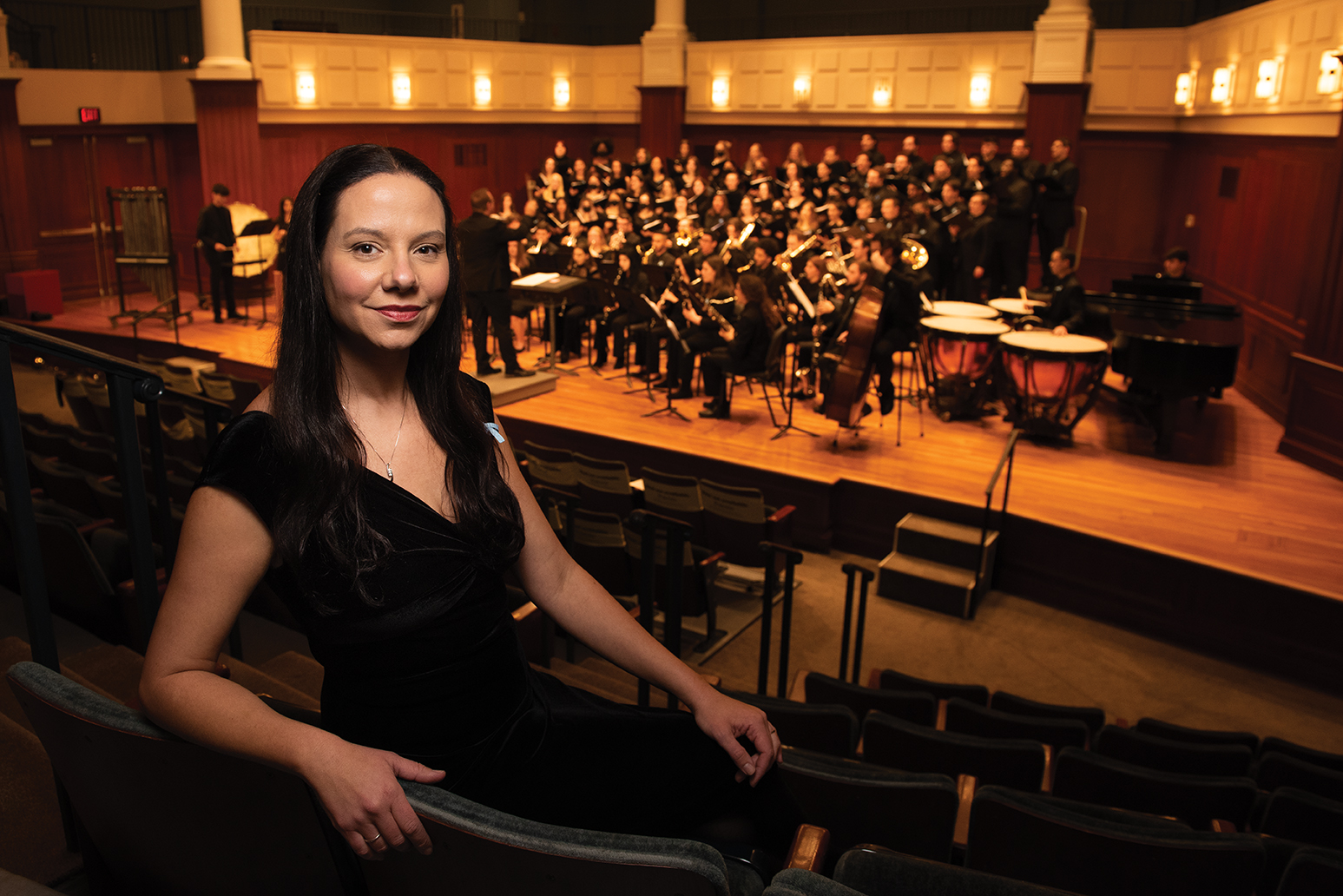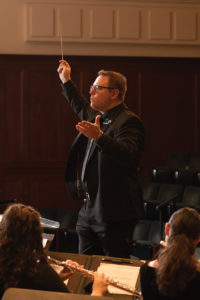The living, breathing Weather
Music department takes its place in the sun as it premieres a first-of-its-kind composition.

Colleen Sears, Assistant Professor of Music at The College of New Jersey, stands before the TCNJ Wind Ensemble and TCNJ Choir in Mayo Concert Hall.
Music department takes its place in the sun as it premieres a first-of-its-kind composition.
Early on in Weather, a musical composition by Rollo A. Dilworth, there’s what might be taken for distant thunder. Soon, a sonic storm, created by the TCNJ Wind Ensemble, is lashing the Mayo Concert Hall. Martial rhythms stomp, briefly, and then give way to massed voices alternately wafting and chopping at the air over the next 18 minutes. Midway, dressed all in black like the other musicians packed onstage, Kyla Eloi ’24 steps forward to lead the audience in a recitation of names — George Floyd, Breonna Taylor, Ahmaud Arbery, Eric Garner, Trayvon Martin — as the singers on stage cry “Say their names.”
“The violence of again,” author Claudia Rankine called it in Weather, the poem Dilworth’s composition is based on, which she wrote less than a month after a Minneapolis policeman knelt on Floyd’s neck, killing him.
Over two nights in October, the Wind Ensemble, along with the Chorale and the College Choir, performed the world premiere of Dilworth’s setting of the poem, commissioned by TCNJ’s music department and The Artivism Project. Colleen Sears, chair of the music department, launched Artivism in 2014 to bring together students and instructors for collaborative explorations of social justice issues through an art lens.
Each Artivism project employs what Sears calls a “driver” piece. In 2015, for example, composer Ted Hearne’s oratorio Katrina Ballads drove an examination of equity in the aftermath of Hurricane Katrina. Springs Eternal, a 2019 exhibit at the TCNJ Art Gallery, centered on water, climate change, and environmental justice.
In June 2020, with the COVID-19 pandemic raging and America in turmoil over issues of race and power, Sears says she was “doomscrolling” on her cellphone when she came across Rankine’s poem in the New York Times Book Review. It read, in part:
… There’s an umbrella
by the door, not for yesterday but
for the weather
that’s here. I say weather but I mean
a form of governing that deals
out death
and names it living. I say weather
but I mean
a November that won’t be held off.
This time
nothing, no one forgotten. We are
here for the storm
that’s storming because what’s taken
matters.
“Her word choice, the starkness of it, just struck me,” Sears says. “This notion that we’re on the cusp of something, and there are no promises that things are going to turn out well.”
Sears flagged Rankine’s poem as a potential Artivism driver. Among the collaborators who “jumped on board immediately,” she says, were Wind Ensemble director Eric Laprade and John Leonard, director of the Chorale and College Choir.

What impressed Laprade was the way the piece “grapples with the current state of our society, head-on, and unapologetically so,” he says.
Leonard knew Dilworth, a professor at Temple University, was interested in creating a work to speak to Floyd’s death. “I sent the poem to Rollo and he said, ‘Oh my gosh, this is it,’” says Leonard. “And we all started working together on this.”
Crucially, the initial pitch for Weather generated financial support from 20 other universities across the country including MIT, Northwestern, and Penn State. “It costs a lot of money to do a project like this,” says Leonard. “But we were committed to doing it, and believed that other institutions would want to join us, and the response was extraordinary.”
While Dilworth wrote and refined the music, the project snowballed across disciplines at TCNJ. A feminist theory class conducted a podcast about social justice, and students from a music, social justice, and education class created soundscapes inspired by the poem. Those sounds influenced graphic design students, who created posters for the concert. Criminology students conducted research about the people whose deaths are woven into the fabric of the piece.
In discussions with students over the two semesters that the piece took shape, participants confronted questions of white privilege. “We intentionally wanted to lean into the discomfort,” says Sears.
“You could be someone who was empathizing with anti-Black racism, but didn’t really experience it, but it still spoke to you and it still called you to action,” says Chorale member Alekhya Madiraju ’22. “It told a story for everyone.”
Weather demanded “a new way to study a piece of music,” Laprade says. In fact, Sears has written a companion curriculum for high schools and colleges to guide student discussions of the myriad of issues raised by the piece.
In Dilworth’s work, vocalists sing “I can’t breathe” 27 times, the number of times Floyd spoke those words as he died. Essential to the composition is the blending of human voices and wind instruments, a somewhat uncommon pairing in chamber pieces, says Leonard. But the idea of sounds created by human breath, as opposed to stringed instruments, “was really a valuable part” of Dilworth’s approach to the project, he says.
Onstage at Mayo, Eloi found herself profoundly moved. “Being able to hear that big sound again after all of that time, it just … felt so nice.”
Madiraju said she was “actually crying” behind her mask as she sang.
The Wind Ensemble and choirs will take Weather to Baltimore where they are scheduled to perform at the Eastern Division Conference of the College Band Directors National Association in February. And, over the next year, members of the supporting consortium will play it on their home stages, from Santa Cruz, California, to Rochester, New York.
TCNJ, though, will forever be where Weather took shape and came to life.
“This piece of music is going to live in perpetuity,” says Laprade. “It’s going to be here far beyond any of us.”
Pictures: Peter Murphy
Posted on February 7, 2022

